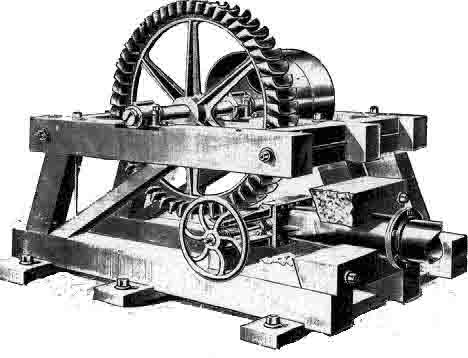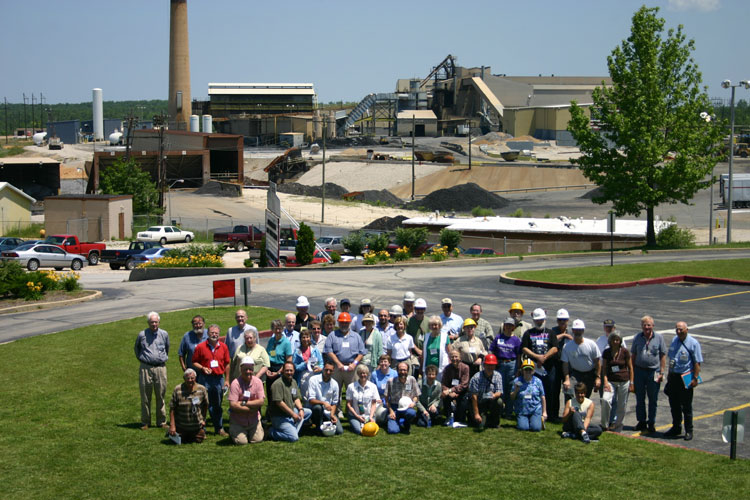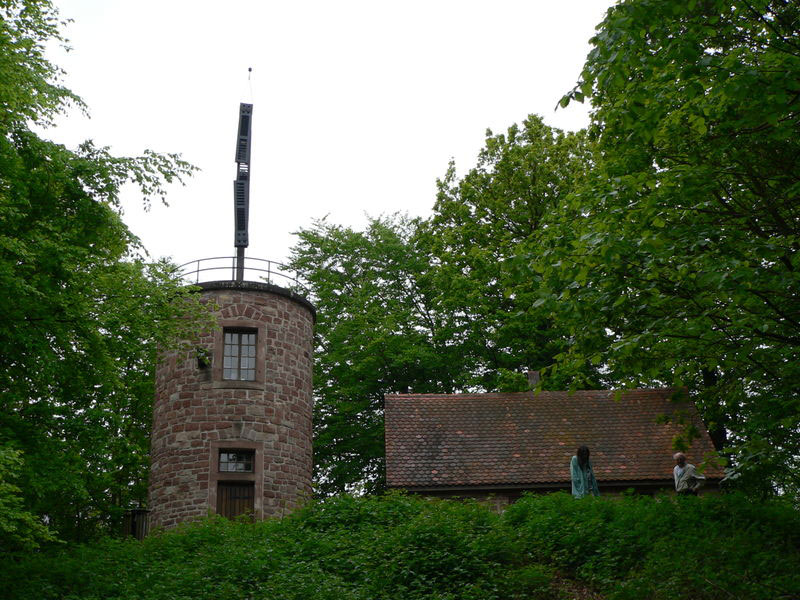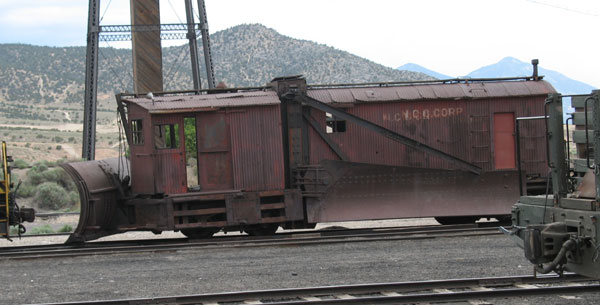
|
Newsletter The Samuel Knight Chapter The Society for Industrial Archeology Issue Number 21 July 27, 2006 |
Contents:
Chapter News
Planned Events
Dinner Meeting with Dr. Gray Brechin
Dues Reduced
SIA National
Conference, June 1-3, Saint Louis, MO
Fall Tour,
September 28-October 1, Youngstown, OH
Notes and Tidbits
Noel’s Travels
IA on the Mother
Road and the Loneliest Highway
Book Review: Brunel The Man Who Built the World
by Steven Brindle
Book Review: The
Victorian Internet by Tom Standage
Wikis, Mashups
and Maps
NUMMI Tours
Copyright © 2006 Samuel Knight Chapter of the Society for Industrial Archeology.
The Newsletter is published in December, April and August, with special issues when they are needed.
The Chapter web site is hosted by the SIA headquarters site:
http://www.sia-web.org/chapters/knight/knight.html
Chapter News
Planned Events
Two Chapter events are in the planning stage. The Annual Meeting will be on Saturday, October 7, 2006 at the Western Railway Museum between Fairfield and Rio Vista on CA12. The Museum features operating trolley cars from their rich collection. We will convene for a brief business meeting at 1:30PM, allowing lots of time to roam around and ride the trolleys. There is a $10 fee for admission which includes the trolley rides. See: http://www.wrm.org
The second is a dinner meeting featuring a discussion with Betty Marvin from the Oakland Community and Economic Development Agency. The date and location have not been finalized, but this will be another dinner meeting.
Dinner Meeting with Dr. Gray Brechin
On March 29, 2006, the Chapter held it’s first dinner meeting, which featured a talk and slide show by noted Bay Area historian Dr. Gray Brechin on his new project, a book documenting the New Deal Legacy. The meeting was held at Spenger’s Seafood Grotto in Berkeley, itself a Bay Area institution.
Dr. Brechin is the author a several books on Bay Area history. He had copies of his latest work Imperial San Francisco, which several members purchased and got his autograph.
His newest project is to document the legacy of the various New Deal agencies, initially on the Bay Area, but eventually expanding to cover more localities. The New Deal’s impact has been largely forgotten, both from the passage of time and from active efforts to discredit the effort. The image of WPA workers leaning on their shovels can be shown to be patently incorrect, as these workers created a huge amount of the infrastructure all around us. It is too easy to forget that a lovely space like the Berkeley Botanical Garden or the monumental Rincon Annex were created by New Deal agencies.It is also remarkable that these projects were almost all for the public benefit, to be used and enjoyed by everyone versus the today’s special interests focus.
Dr. Brechin had lots of slides showing projects all over California that were built by New Deal agencies. This was an eye opening experience. For example, I had no idea that the WPA had built a large number of schools in Southern California after the 1933 Long Beach earthquake had destroyed many of the existing schools.
The work is targeted at producing an illustrated book on the New Deal Legacy, ideally in time for the 75th anniversary of the beginning of the New Deal in 2008. As work on the project started, it became clear that the project could become far larger. Preliminary planning is underway to create a publicly accessible web site with a database of images and discussion of New Deal projects. An early version of the site can be found at: http://www.newdealproject.org
The dinner was quite well attended, including some new members. There was a lively discussion after Dr. Brechin’s talk. Members had been asking to have events like this for a while. Its success means that we’ll schedule other dinner meetings in the coming months. JM

Chapter President Tony Meadow presents Dr. Gray Brechin an SIA Hat and Pin
Dues Reduced
Our efforts to reduce the costs of Chapter mailings have paid off. The costs of a newsletter issue have dropped by 2/3, despite higher costs for postage and reproduction. The Chapter has a substantial surplus, so in early 2006, the Board voted to simplify the dues structure and to reduce the Chapter dues to a flat $10/year. A few members had renewed at the previous rate ($25/year), and their memberships will be extended through 2008. Note that the Chapter membership voted not to seek tax-exempt status, so Chapter dues are not tax deductible.
SIA National Conference, June 1-3, Saint Louis, MO
Only a few Chapter members attended the SIA National Conference in Saint Louis, but for those of us who were able to make it, the Conference was quite interesting.
The Conference hotel, the Hyatt Regency at Union Station, was a very appropriate venue, as an excellent example of creative adaptive reuse. The magnificent structure was opened in 1894 and was one of the largest and busiest train stations in the country. The station building has been repurposed into the hotel lobby and part of a shopping center. The hotel rooms are actually a new building on the site of the former tracks. Signage throughout the shopping center helps tie the site back to its heritage.
The early bird tours on Thursday gave early arriving participants a tour of the brewing industry, as well as other choices. We opted for beer! We started at a local microbrewery, Schafley Brewing. Half the group got a really detailed discussion on the process, but the second half was more rushed, as tour leader Susan Appel worked hard to keep us on schedule. The southern part of St. Louis has a great may caves in the limestone rock on which it sits. These were used by the newly introduced German lager beer breweries in the 19th century. Lager beer requires storage at cool temperatures, and in the era before mechanical refrigeration, these caves were just right for storing beer. There is a rich history of brewing in St. Louis, but prohibition killed a number of breweries. After a fascinating visit to the former Lemp brewery, including a tour through the catacombs under the brewery, we wound up at the massive Anheuser-Busch complex. The process is the same as the Schafley Brewery, but massively larger in scale.
Reports from the group visiting the Wicks Organ Company also were very positive.
The opening reception was held the Missouri History Museum, and featured a talk by Dr. Robert Archibald, President of the Missouri Historical Society.
Friday featured a variety of tours. I opted for All Mining, All the Time, a tour of the lead mining region south of St. Louis, with a very enthusiastic mining historian, Art Herbank. Our first major stop was the Doe Run Resource Recovery Division site. This former lead mine and smelter has been converted to a state-of-the-art lead recycling facility. Much of the input stream is batteries, but all sorts of lead bearing materials are processed. Of particular note was the site’s processing of CRT’s. The site has a smelter, and uses silica to remove impurities from the lead, producing slag. So, CRTs which contain significant amounts of lead in the glass, are an excellent raw material, not to mention addressing a tough environmental problem regarding CRT disposal. Another favorite was the Missouri Mines Historical Site, a large mine-mill complex, a fascinating IA site!

SIA Tour, Doe Run Resource Recovery Division

Former St. Joe Ore Concentration Complex, Missouri Mines Historic Site
The Saturday paper sessions had a very wide range of topics. Former Chapter member Scott See presented his work on taxonomy the mine shaft-rock houses of the copper mines in the Upper Peninsula of Michigan. Scott has elected to pursue a Ph.D. at Michigan Tech in IA, we wish him all the best!
It was a little tough getting up Sunday morning after the banquet Saturday at the Morgan Street Brewery in a tiny preserved pocket of the St. Louis waterfront, but the lure of a guided tour of the historic Eads Bridge was a powerful incentive. This was followed by a riverboat brunch. The day and the conference ended with a series of architectural walking tours. We chose one featuring some of the controversies about preservation and growth. JM
Fall Tour, September 28-October 1, Youngstown, OH
Although SIA National members will receive a mailing in early August, it’s not too early to mark your calendars for what looks to be very rich fall tour. There will be a pre-event excursion to Erie, PA to look at the industrial heritage of the area. A wide variety of local industrial process and industrial heritage tours are planned around the greater Youngstown area. Youngstown State University, has an active Industrial History program, with staff and students pitching in on the planning and execution of the Fall Tour.
Notes and Tidbits
Noel’s Travels
(Some interesting journeys by Chapter member Noel Kirshenbaum.)
I've traveled a good deal since the Bologna SIA trip. In March, I accompanied my son to Strasbourg and Zurich where he gave a couple of university talks. Subsequently, while visiting Lyon, I noticed an historical plaque on the bank of the Saône River attesting to the first trials of a steam-powered vessel. I thought to myself, what about Robert Fulton? In the old days, I was taught that Fulton's Clemont (often called Clermont or even Claremont -- after the Berkeley hotel, of course) was The First. So, on returning home, I did a little research and found that John Fitch, an American, built and operated a steamboat on the Delaware River in 1787. It was not financially successful, but Fulton was the first to achieve commercial success in 1807 and became famous with the Clemont. I confirmed that prior to this, in Lyon in 1783, the Marquis Claude de Jouffroy d'Abbans had tested a steam engine on a boat on the Saône River in Lyon.
On the same trip, on a mountain top west of Strasbourg, I visited a semaphore tower -- at an optical telegraph "station" near Saverne. This was considered something like Napoleon's secret weapon. This station was one of fifty on the line that linked Paris with Strasbourg. Built in the 1790s, it transmitted messages during the revolution, when cities were in revolt, and foreign forces surrounding France. The network covered France and was used until the 1850s. (These optical telegraphs are discussed in The Victorian Internet, reviewed below. The term telegraph was invented as the name of these devices. JM)

Optical Telegraph Station near Saverne, France
In April, I missed the earthquake centennial to give a paper in New Zealand at the Buckets of Gold Conference. My subject was on Gold Dredging in California. Why in New Zealand? Because bucket-line dredges had been developed first in the New Zealand goldfields -- and then, in the 1890s, the technology was brought to California by John Postlethwaite, where dredging and dredge manufacture became an important California industry for many decades. (Our Chapter namesake, Samuel Knight, was an active builder of dredging machinery. JM)
I spent two weeks in the country, mostly in the South Island, the location of a great many gold operations.
In May, I attended the Mining History Association's Annual Meeting in Globe, Arizona. 2006 is an interesting year in Arizona, with copper prices hitting all time highs by a factor of over two. A highlight was a visit to Phelps Dodge's Morenci mine, production from which now exceeds that from the huge Bingham Canyon operation in Utah.
IA on the Mother Road and the Loneliest Highway
By Jay McCauley
It’s been a long time since we’ve taken a cross country road trip, so we decided to make the journey to and from St. Louis for the National Conference via Route 66 out and US50 home.
With the 50th anniversary of the birth of the Interstate Highway system occurring in June, it’s hard to get back to a time when a transcontinental journey by car was a major adventure. Route 66 was not completely paved until 1938, for example. The completion of Route 66 in the 1930s caused fundamental changes in American culture in terms of mobility, commerce, and transportation. These changes are still a subject of intense debate, but they are undeniable.

La Posada, Winslow, AZ
From a historic preservation perspective, a highlight of the trip was lunch at La Posada in Winslow, AZ. This former Harvey House had fallen on hard times as passenger rail traffic dried up, and had been converted into BNSF office space. It was constantly a candidate for destruction. It was saved by a couple who have lovingly restored it to its glory days. Now it’s a fine hotel with an excellent restaurant. Winslow is an active rail yard on the BNSF mainline, so you also get to see lots of trains.
Another excellent example of adaptive reuse was the Route 66 Museum in Kingman, AZ. Housed in a former power house, it has a well curated exhibition on the history and impact of Route 66.
Near the end of our adventure we spent some time at the Nevada Northern Railway, in Ely. They have proposed hosting the 2007 Fall Tour. The railroad had been built in 1905 to service the copper mine, and remained active into the 1990’s when Kennecott Copper abruptly closed the mine and the railroad, offering the railroad to the city. Through a dedicated force of volunteers from all over the world, the railroad operates tourist trains, and hopes soon to interchange freight as there is renewed activity at the mine. There is still a lot of planning to do for the Fall Tour, but I hope that Chapter members will be able to make it to this fascinating place.

Snowplow at Nevada Northern Railway, Ely, NV
For more photos from our visit to the Nevada Northern Railway, click this.
Book Review: Brunel The Man Who Built the World by Steven Brindle
Reviewed by John de Marchi
Steven Brindle, an author and historian, has written a very engaging and well-illustrated book about the life and engineering works of I. K. Brunel. The book is not a scholarly work and lacks any footnotes. But it is clear that it is well researched and full of recent information, which has been uncovered regarding Brunel and his works. It is an easy read and hard to put down once you get started with the wonderful overview introduction by Dan Cruickshank, a well-known BBC presenter.
The first chapter, “Father and Son”, is a very nice sketch of Isambard Kingdom Brunel’s early years and influences and a good overview of his father, Marc Brunel’s impressive engineering works. This chapter also has many wonderful illustrations including reproductions of original drawings. The illustrations are one of the strong points of the book. There are also several double page fold-outs of drawings and a three page fold-out of one of the finest drawings I have ever seen: the Great Eastern, in the Science Museum, London. There are two cross sections of the great ship from stem to stern, with every detail shown, including thousands of individually drawn and colored chunks of coal in the numerous coal-bunkers of the Great Eastern. Since many of the drawings used as illustrations are from Brunel’s hand or from his office they are primary source information and I welcome their inclusion as they show how well thought out many of these complex projects were.
The layout of the chapters of the book are thematic, so there are chapters, dealing with the Thames tunnel, the railways, the bridges, and the three great ships, for example. Often Brunel was working on many projects at the same time, which makes it difficult to tell his story in a straight time line. It is well documented that Brunel was a workaholic and started early in the day and went late into the night, and again the next day with very little sleep. It seems that he had the ability to do this for long periods of time. He also expected much from anyone who was in his employ, in fact if his employees had time for sports or any leisure activity and Brunel became aware of this, they would be warned or fired on the spot. He was a demanding person, both for himself and those in his employ and was very much a 19th century unique and creative engineering giant.
I found the book informative, interesting, and logical in its layout, and easy to follow. The author gives a good account of Brunel the man and his accomplishments, and also his shortcomings. There is documentation of some newly discovered works that have come to light in recent years, an iron bridge over a canal near Paddington Station. I was surprised to learn of some involvement that Brunel had with the Crystal Place, mostly after it was rebuilt at Sydenham. He designed and built two water towers for the complex, for example.
Anyone with an interest in 19-century engineering or Brunel will find much of interest in this volume. Even old Brunel fans will find the illustrations and reproductions of working drawings enough of a reason to purchase this book. Several friends have done so on my recommendation, and have enjoyed it, and recommended it to others.
On April the 9th I attended a small party to celebrate the 200th anniversary of I. K. Brunel; birth and his achievements. One person in attendance had a number of original working drawings for parts of the “Great Britain” from Brunel’s workshop, and they were just beautiful in execution. I have been involved with the fine arts for many years and I have no idea how the draftsmen of that era were able to produce such consistent and perfect water color washes. Steve Brindle’s volume “Brunel” might give the reader some sense of these exquisite drawings and of Brunel “The Man Who Built The World”.
2005, Weidenfeld & Nicolson, London, ISBN 0 297 84408 3
Book Review: The Victorian Internet by Tom Standage
Reviewed by Jay McCauley
The invention of the telegraph in the 19th Century was the first revolution in communications, and has striking parallels with the impact of the Internet. Prior to the invention of the telegraph, communications was at the speed of moving a physical message. In all of civilized history, this speed had increased only by a factor of 10-15. The invention of the telegraph provided for communication over great distances in real time. The author, Tom Standage, conveys the enormous impact rapid communications had on many different facets of commercial and personal life. He draws many parallels with similar changes wrought by the Internet. For example the telegraph changed the way business was conducted, but also opened up new types of crime.
Standage weaves a great tale about genius, eccentricity, greed, innovation, and change, filled with fascinating characters. For example, there the moments of high drama when a damaged Atlantic cable is retrieved, or when the fate of nations is decided in telegraphic exchanges with diplomats and generals.
This is a very readable book and has a good reference list. Standage has written other books after this one, notably The Turk, which discusses a chess playing “robot” presented to the Empress Maria Teresa in the 1700s, whose secret was kept for over 85 years.
1998, Berkeley Books, ISBN 0-425-17169-8
Wikis, Mashups and Maps
By Jay McCauley
Technology keeps moving on, especially in the Internet. Of particular interest to me are community building tools and new ways to look at complex information.
In the past year or so, wikis have become mainstream tools. Briefly, a wiki is a website whose content is provided by a user community. Perhaps the best known wiki is wikipedia, an on-line encyclopedia whose content is created by interested people with very little editorial oversight or review. Rather, an active community looks to keep articles accurate. This can lead to difficulties on controversial topics or uncaught obscure errors, but by and large this is a hugely successful site. Some months ago, as an experiment, I set up
http://norcalindustrialheritage.pbwiki.com/
pbwiki.com is free for casual users, and the setup only took a couple minutes. I liked the idea, but as I started to work on the wiki, the organization of the information became tangled. For example, how, without a LOT of indexing work could I help a user find IA/IH sites near some place they were visiting?
Enter the mashup. Mashups are web sites that are the result of combining information from two or more web sites. Mashups exploded on the scene as first google then Yahoo! (and others) created interfaces to powerful mapping systems. Now, you could take a list of addresses from one web site and plot the data as an overlay to a map, including the sub-meter accurate google satellite/aerial photos of almost all of the US.
So, I stopped working on norcalindustrialheritage, and started a new experiment at wayfaring.com (also free) where one can create map “pushpins” that have popup information bubbles when they are clicked. Ah! Just what I was looking for!
http://www.wayfaring.com/maps/show/15166
is a map, Northern California Industrial Heritage, showing some of the places the Chapter has visited over the years and other relevant sites.
http://www.wayfaring.com/maps/show/15198
is a map of the venues for the 2006 National Conference in St. Louis, including a few uploaded pictures.
All this is a work in progress, but provides some interesting new ways to display information. A current project involves creating a database driven web site to select and display images and maps showing their locations, as an experiment for the New Deal Legacy Project.
NUMMI Tours
New United Motor Manufacturing Inc. is a joint venture between GM and Toyota and operates an assembly plant in Fremont, CA. I recently found out that they offer a free 1.5 hr. tour of the plant. Since tours are only offered on weekdays, and require advanced reservations, it’s not practical as a Chapter event. However, if you haven’t seen a modern auto assembly operation, consider making a trip to NUMMI. See: http://www.nummi.com/tours.html